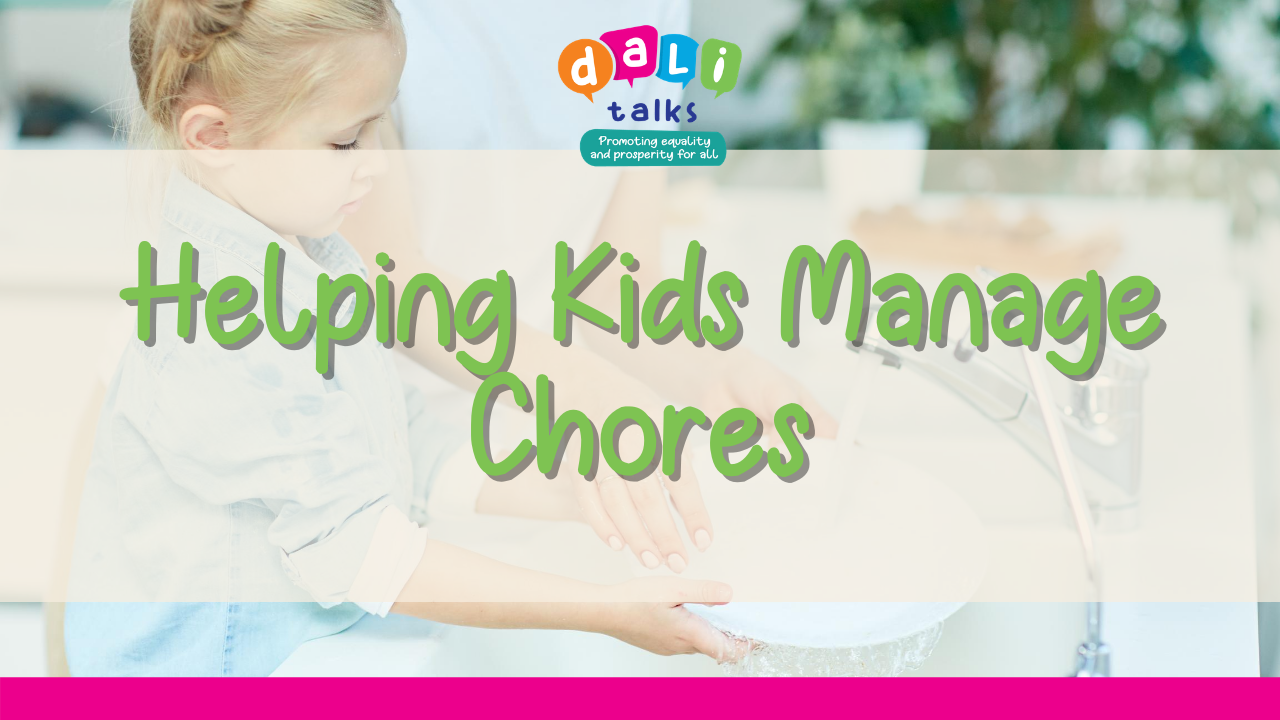Helping Kids Manage Chores

I walked into my daughter’s room and my irritability immediately shot up! After days of reminding her to clean her room, it appeared as if she hadn’t made any attempt whatsoever to improve the mess.
Can you relate?
Surely, every parent has experienced this type of frustration and anger. As I stood there looking at everything in that room, I realized that a lot of it was my fault.
It’s A Parent’s Responsibility
You see, my husband and I were the ones who allowed all the toys to come into the house. The high stack of stuffed animals didn’t just appear out of nowhere. And the overfilled hamper hadn’t been checked for two weeks.

When you make cleaning playful for kids, it doesn’t seem like a burden to do chores.
Similarly, the closet hadn’t been inspected by my husband or me either. Why? Because we were exhausted and we decided to see what would happen if we didn’t stay on top of their chores.
Now, in our house, there are chores and then there are personal chores.
Let me explain. Chores or “community chores” are tasks that must be done in order to help maintain a neat and clean home. The areas included are common areas such as the loft, dining room, formal living room, guest bath, kitchen, etc.
Personal chores are tasks that are beneficial to one person. That would be doing one’s own laundry, cleaning one’s room, and bathroom.
They’re really not too bad…if you work on them often.
So, when I walked into my daughter’s room and saw that hot mess in there, It made my head spin!
Studies show that the more toys or clothes that kids have, the more overwhelm and anxiety they experience.
It was a visual that I just could not comprehend. How could ANYONE live like this? I mean, the floor was COVERED with all sorts of things. Notebooks, clothes, toys, book bags, boxes, SLIME!
O.M.G. I wanted a tornado to come through and pick up all that crap and haul it outta there!
So, after many weeks of pleading and yelling, I decided to offer them the opportunity to break up their personal and regular chores into mini-tasks.
Why? Because when we have smaller tasks, they’re more achievable and less frustrating to get done.
For a child, this can be GOLDEN!
Break It Down
Therefore, in order to help you to get your child to accomplish more of his or her chores, I’ve created a list of chores to consider if your child is 10-years young or older.
Now, I understand that not all kids ages 10 and older are mature enough to handle certain chores. So, keep in mind that this list is not set in stone and you can change out the tasks as you see fit.
The point of this list is so that you can assign some mini-tasks that can be built on over the week or over the month. This way, by the end of the week or month, they can see that they have contributed to helping keep their home tidy. Most of all, they’ll feel well accomplished!

You can get kids excited about helping with chores when you make it fun and start with very small chores, like handing over articles of clothing or separating colors. And while you’re at it, you can make it into a game or an educational experience.
I’m not suggesting you use your children as the housekeepers! NO. That’s not it. The point is to teach them to be responsible and learn to manage their time and responsibilities better. You should always start by helping them with their chores until they can handle the task alone.
The Benefits
When doing this, you also show them the standard that’s expected. Just be sure that you do not give them an unrealistic chore.
By keeping their own space clean and organized, they’ll also notice that cleaning their rooms and restrooms will become much easier and take less time.
How do you eat an elephant? One bite at a time. Right? Same thing with a large task. You start one tiny chore at a time until you’ve done it all.
Lastly, when kids contribute to their own home maintenance, they appreciate more and have higher self-esteem as well as take more pride in the work that took into helping create beautiful, clean spaces in their homes.
Kids who are able to help around the house with chores have higher self-esteem and feel more valued. They also tend to learn to care for things more because they understand how much work goes into keeping a clean, organized house.
Here’s The Plan
Because I really want to help you keep your sanity and help your child, I created a fun sheet with a list of tasks broken up into mini-tasks.
I recommend you take a big wall calendar and stick a mini-task on chosen weekdays as a reminder of what is to be done each day. You can find wall-size calendars at the Dollar General or Dollar Stores. Sometimes you can even find fancy looking ones at HomeGoods between $5 and $20.
If you start implementing small, manageable chores at a young age, while also helping them do them, then they will make chores a good habit and know the standard.
This good habit will help everyone at home be more at peace and enjoy the home rather than looking at it as a dreaded burden to keep clean.
If you have a system that works really well, I’d love to learn about it. Please feel free to share your methods with us and don’t forget to download the Mini Chores List fun sheet.

